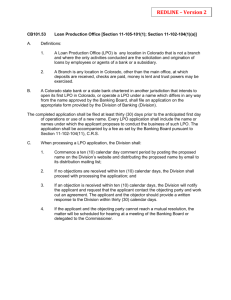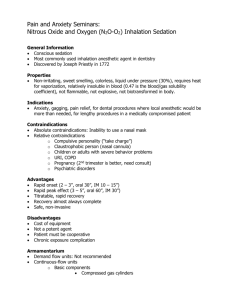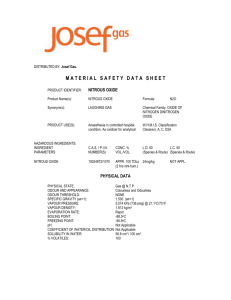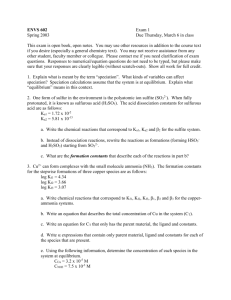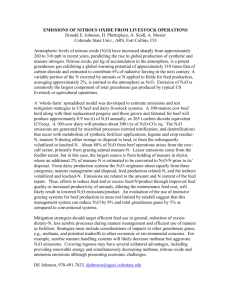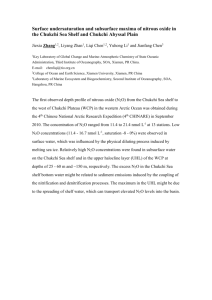Interannual variability in tropospheric nitrous oxide Please share
advertisement
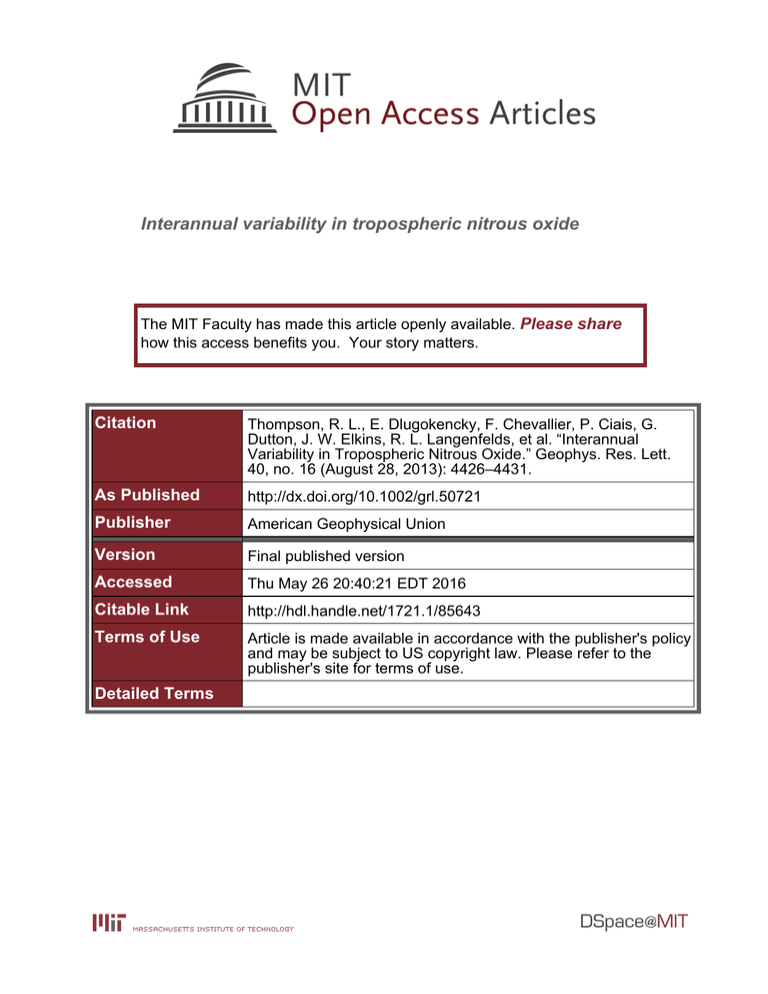
Interannual variability in tropospheric nitrous oxide The MIT Faculty has made this article openly available. Please share how this access benefits you. Your story matters. Citation Thompson, R. L., E. Dlugokencky, F. Chevallier, P. Ciais, G. Dutton, J. W. Elkins, R. L. Langenfelds, et al. “Interannual Variability in Tropospheric Nitrous Oxide.” Geophys. Res. Lett. 40, no. 16 (August 28, 2013): 4426–4431. As Published http://dx.doi.org/10.1002/grl.50721 Publisher American Geophysical Union Version Final published version Accessed Thu May 26 20:40:21 EDT 2016 Citable Link http://hdl.handle.net/1721.1/85643 Terms of Use Article is made available in accordance with the publisher's policy and may be subject to US copyright law. Please refer to the publisher's site for terms of use. Detailed Terms GEOPHYSICAL RESEARCH LETTERS, VOL. 40, 4426–4431, doi:10.1002/grl.50721, 2013 Interannual variability in tropospheric nitrous oxide R. L. Thompson,1 E. Dlugokencky,2 F. Chevallier,3 P. Ciais,3 G. Dutton,2 J. W. Elkins,2 R. L. Langenfelds,4 R. G. Prinn,5 R. F. Weiss,6 Y. Tohjima,7 S. O’Doherty,8 P. B. Krummel,4 P. Fraser,4 and L. P. Steele4 Received 18 March 2013; revised 26 June 2013; accepted 2 July 2013; published 27 August 2013. [1] Observations of tropospheric N2O mixing ratio show significant variability on interannual timescales (0.2 ppb, 1 standard deviation). We found that interannual variability in N2O is weakly correlated with that in CFC-12 and SF6 for the northern extratropics and more strongly correlated for the southern extratropics, suggesting that interannual variability in all these species is influenced by large-scale atmospheric circulation changes and, for SF6 in particular, interhemispheric transport. N2O interannual variability was not, however, correlated with polar lower stratospheric temperature, which is used as a proxy for stratosphere-to-troposphere transport in the extratropics. This suggests that stratosphere-to-troposphere transport is not a dominant factor in year-to-year variations in N2O growth rate. Instead, we found strong correlations of N2O interannual variability with the Multivariate ENSO Index. The climate variables, precipitation, soil moisture, and temperature were also found to be significantly correlated with N2O interannual variability, suggesting that climate-driven changes in soil N2O flux may be important for variations in N2O growth rate. Citation: Thompson, R. L., et al. (2013), Interannual variability in tropospheric nitrous oxide, Geophys. Res. Lett., 40, 4426–4431, doi:10.1002/grl.50721. 1. Introduction [2] Nitrous oxide (N2O) is now the third most important long-lived anthropogenic greenhouse gas. N2O is also an important ozone-depleting substance (ODS), as it reacts with O(1D) to produce NO in the stratosphere, and currently the ozone-depleting potential-weighted emissions of N2O are considered the largest of any ODS [Ravishankara et al., Additional supporting information may be found in the online version of this article. 1 Norwegian Institute for Air Research, Kjeller, Norway. 2 Global Monitoring Division, Earth System Research Laboratory (ESRL), National Oceanic and Atmospheric Administration, Boulder, Colorado, USA. 3 Laboratoire des Sciences du Climate et de l’Environnement, Gif-surYvette, France. 4 Centre for Australian Weather and Climate Research/Commonwealth Scientific and Industrial Research Organisation, Aspendale, Victoria, Australia. 5 Massachusetts Institute of Technology, Cambridge, Massachusetts, USA. 6 Scripps Institution of Oceanography, University of California, San Diego, La Jolla, California, USA. 7 National Institute for Environmental Studies, Tsukuba, Japan. 8 University of Bristol, Bristol, United Kingdom. Corresponding author: R. L. Thompson, Norwegian Institute for Air Research, Instituttveien 18, Kjeller 2027, Norway. (rona.thompson@nilu.no) ©2013. American Geophysical Union. All Rights Reserved. 0094-8276/13/10.1002/grl.50721 2009]. The atmospheric mixing ratio of N2O has been increasing strongly since the preindustrial era largely as the result of human activities, namely the increasing input of reactive nitrogen into ecosystems (predominantly by N fertilizer use), which accelerates denitrification rates and enhances N2O emissions from soils and coastal waters to the atmosphere [Syakila and Kroeze, 2011]. [3] Atmospheric observations of N2O began in the early 1970s and have revealed a steady quasi-linear increase in concentrations since then [Prinn et al., 1990]. Superimposed on this long-term trend are seasonal and interannual variations. The seasonal variability in N2O mixing ratio is determined by the combined effect of transport and surface fluxes. Of particular importance is stratosphere-to-troposphere transport (STT), which brings air with a low N2O mixing ratio from the stratosphere into the troposphere. STT has a maximum in spring in the Northern Hemisphere and is particularly important in defining the seasonal cycle in middle to high latitudes [Ishijima et al., 2010; Nevison et al., 2004; Nevison et al., 2007; Nevison et al., 2011]. The interannual variability in N2O mixing ratio has only been investigated in a few studies [Ishijima et al., 2009; Nevison et al., 2007; Nevison et al., 2011], which has partly been due to the limited availability of long-term measurements of N2O precise enough to be used for this purpose. In the late 1990s and early 2000s, measurements of N2O began at a number of new sites and provide measurements precise enough to be used for such a study. Previous investigations have pointed to an important role of STT in N2O interannual variability [Nevison et al., 2007; Nevison et al., 2011]. This is based on the observed correlation between anomalies in N2O minima at middle- to high-latitude sites and anomalies in polar lower stratospheric temperature (PLST), which is used as a proxy for the strength of the Brewer-Dobson circulation and STT [Huck et al., 2005; Waugh et al., 1999]. [4] Here we examine tropospheric N2O from 1996 to 2009 to better understand the importance of atmospheric transport and surface flux variability on N2O interannual variability. We exploit a data set encompassing 30 flask and 6 in situ sites (see Table S1 in the supporting information) and utilize observations of two other atmospheric trace gases, CFC-12 (CF2Cl2) and SF6, which are useful tracers for atmospheric transport and have been previously used in investigating seasonal variability in N2O [Nevison et al., 2007]. 2. Observations and Model [5] Approximately weekly N2O measurements from discrete air samples (flasks) are used from the NOAA CCGG (Carbon Cycle Greenhouse Gases group) (E. Dlugokencky et al., in preparation, 2013) and the Commonwealth Scientific and Industrial Research Organisation (CSIRO) 4426 THOMPSON ET AL.: TROPOSPHERIC NITROUS OXIDE VARIABILITY [Francey et al., 2003] global networks. In situ measurements are used from AGAGE (Advanced Global Atmospheric Gases Experiment) [Prinn et al., 2000] and NIES (National Institute for Environmental Studies) sites [Tohjima et al., 2000] (see Table S1 in the supporting information). For AGAGE sites, the data are available at 40 min intervals while for NIES sites, the data are available as daily averages. Flask and in situ measurements are made using gas chromatographs fitted with electron capture detectors (GC-ECD) and are reported as dry air mole fractions (nmol mol 1, abbreviated ppb). NOAA and CSIRO data are reported on the NOAA2006A scale [Hall et al., 2007], while AGAGE and NIES data are reported on the SIO-1998 and NIES scales, respectively. AGAGE data were adjusted to the NOAA-2006A scale by comparing measurements at sites where AGAGE and NOAA operate in parallel, while NIES data were adjusted based on the results of intercomparisons of standards (Δχ = 0.6 ppb, Y. Tohjima, personal communication, 2012). There is some concern that there may be a calibration shift between CCGG N2O data collected before and after 2001. For this reason, we run our analyses twice, first using all available sites and, second, using a subset of sites (“core” sites), which excludes CCGG sites and sites with large data gaps (>6 months) (see Table S1). CFC-12 and SF6 measurements are from flasks in the NOAA HATS (Halocarbons and other Atmospheric Trace Species) network and in situ instruments in the AGAGE network. Both measurements are made using GC-ECD and presented as dry air mole fractions (pmol mol 1, abbreviated ppt). CFC-12 measurements are reported monthly on the NOAA-2008 (HATS) and SIO-2005 (AGAGE) scales and SF6 measurements on the NOAA-2006 (HATS) and SIO2005 (AGAGE) scales. [6] Interannual variability (IAV) was calculated for N2O at each site used in this study by first subtracting the multiannual trend, fitted as a second-order polynomial, and then applying a low-pass Butterworth filter (fourth order) to the residuals to filter seasonal and higher-frequency signals. Two passes of the filter (forward and reverse) were applied to correct for any phase distortion. This method was chosen preferentially over methods that involve fitting a seasonal cycle to the data (e.g., based on harmonic curves) since at many sites the seasonality has small amplitude and/or is irregular. Our definition of IAV is the component of the signal with periodicities longer than 12 months and is closely correlated with the growth rate. The Butterworth filter has been used previously to examine IAV in atmospheric species, e.g., in the studies of Ishijima et al. [2009] and Nakazawa et al. [1997]. Both methods, however, were tested and gave consistent results. The same method was applied to CFC-12 and SF6, but for CFC-12 a third-order polynomial was used to fit the multiannual trend. [7] Atmospheric simulations of N2O were performed using the Laboratoire de Météorologie Dynamique general circulation model (LMDz, version 4) [Hourdin et al., 2006], which includes N2O photolysis and oxidation reactions in the stratosphere and has an N2O lifetime of approximately 120 years which is within the range of recent estimates of 131 ± 10 years [Prather et al., 2012]. LMDz has a horizontal resolution of 3.75° longitude × 2.5° latitude and 19 hybrid pressure levels up to 3 hPa. Modeled transport was nudged to European Centre for Medium-Range Weather Forecasts (ECMWF) ERA-40 wind fields at 6-hourly intervals. The model was run with climatological monthly N2O emission estimates comprising natural and agricultural soil fluxes, ocean fluxes, as well as biomass burning and anthropogenic (nonagricultural) emissions (for details see the supporting information). 3. Results and Discussion [8] IAV in N2O, CFC-12, and SF6 is shown for the tropics and the northern and southern extratropics from 1996 to 2009 (Figure 1). The standard deviation of N2O IAV is approximately 0.2 ppb and is significant compared to the variability across all sites used within each region (for details see Table S2). N2O IAV is weakly correlated with CFC-12 IAV in the northern extratropics, more strongly correlated in the southern extratropics, and uncorrelated in the tropics (see Table 1). CFC-12, like N2O, is only lost by photochemical reactions in the stratosphere and has a similar lifetime to N2O (108 years [Rigby et al., 2012]). This, and given that there is little seasonal and interannual variability in CFC-12 emissions, means that it is a pertinent tracer for the influence of STT. The fact that IAV in N2O and CFC-12 is only weakly correlated in the northern extratropics suggests that STT is not the dominant factor in N2O variability at these latitudes. IAV in N2O and SF6 is also only weakly correlated in the northern extratropics but is more strongly correlated in the tropics and southern extratropics. SF6 is a very long-lived species (lifetime of 3200 years [Ravishankara et al., 1993]) with no loss in the stratosphere, making variations in the tropospheric mixing ratio less sensitive to STT than, e.g., N2O or CFC-12. In addition, its emissions have little seasonal or interannual variability, making it a useful tracer for tropospheric transport. Emissions of SF6 are predominantly in the Northern Hemisphere and SF6 has a strong north-south concentration gradient. Therefore, the correlation of IAV in N2O with that of SF6 in the southern extratropics likely results from variations in interhemispheric transport. [9] Anomalies in N2O seasonal minima at a number of middle- and high-latitude sites are correlated with anomalies in PLST (used as a proxy for STT) as shown by Nevison et al. [2011]. However, we also find substantial variability in the N2O maxima, which is not correlated with variability in the N2O minima and cannot be explained by STT alone. Comparing N2O IAV (which is sensitive to anomalies in both the maxima and minima) in the northern (southern) extratropics with Arctic (Antarctic) PLST, we find no significant correlation (see Table S3). This indicates that STT alone cannot explain the observed IAV in N2O in the middle to high latitudes. Another test for the influence of STT is to look at the magnitude of this effect. Following Nevison et al. [2007], we estimate the change in tropospheric N2O mixing ratio from variations in STT on interannual timescales. Assuming annually balanced upward and downward air mass fluxes, a N2O cross-tropopause gradient of 20 ppb, and a net global downward flux of between 4 × 109 and 11.6 × 109 kg s 1 (median of 5.9 × 109 kg s 1, n = 3) [Gettelman et al., 1997; Schoeberl, 2004] with a 20% interannual variation (this number is very uncertain [Schoeberl, 2004]) results in a range of 0.5–1.4 yr 1 interannual variation in the tropospheric mass of N2O. This equates to 0.11–0.32 ppb IAV in the N2O tropospheric mixing ratio, of which only the upper limit (i.e., 0.32 ppb) would have about the right magnitude to explain the observed IAV. 4427 THOMPSON ET AL.: TROPOSPHERIC NITROUS OXIDE VARIABILITY Figure 1. IAV of N2O, CFC-12, and SF6 shown for northern (North) and southern (South) extratropical and tropical regions. The solid blue curve is the mean and the shaded blue area is the standard deviation of IAV calculated at all sites. For N2O, the red line shows the mean value of IAV calculated using the core sites only (see also Table S1). [10] Examining the latitudinal pattern of N2O IAV, we find that there is a strong tropical and subtropical signal that is closely in phase across hemispheres and which is negatively correlated with the Multivariate ENSO Index (MEI) (http:// www.esrl.noaa.gov/psd/enso/mei/) such that negative N2O anomalies coincide with El Niño conditions (see Figure 2). A correlation of N2O IAV with ENSO has been previously detected in long-term N2O shipboard measurements in the northern and western Pacific [Ishijima et al., 2009] and from in situ measurements at Samoa [Nevison et al., 2007]. We find the strongest correlation with a lag time of between 7 and 9 months in the tropics (R = 0.61) and southern extratropics (R = 0.59), and between 9 and 11 months in the northern extratropics (R = 0.67, see Table 1). In the tropics, CFC-12 IAV (at Samoa) is also correlated with ENSO (R = 0.41). Changes in interhemispheric transport, which is affected by ENSO-driven changes in circulation, has been suggested as a mechanism for this correlation and has been observed for other species at Samoa (e.g., methane and methylchloroform) [Hartley and Black, 1995; Prinn et al., 1992]. For N2O the IAV is closely in phase for both hemispheres; however, if changes in interhemispheric transport were mainly responsible for the IAV, then the signal in each hemisphere should be out of phase [Steele et al., 1992]. Also, for species with strong biogenic sources, such as N2O, this correlation may be partly due to variability in the emissions related to ENSO-driven climate changes. We examine the influence of tropospheric transport and emission variability on N2O IAV in the following paragraphs. [11] The transport influence on tropospheric N2O variability was modeled using LMDz, and time series for each site were extracted from the 4-D simulated N2O mixing ratios and analyzed in the same way as the observations (see section above). IAV at different sites were then averaged in five geographical regions (see Table S2). Our model (which does not account for IAV in N2O emissions) captures about 40% of the observed variation in IAV in extratropical regions and none in the tropics (see Figure 3). Simulations using IAV in the emissions (not shown) did not perform better owing to large uncertainties in the emission variability. The model-observation difference for all regions may be partly due to model transport errors, but on the basis of comparisons with CFC-12, for which the agreement is much better (R = 0.57 for the northern extratropics and R = 0.47 for the Table 1. Correlation of N2O IAV With That of the Trace Gases, CFC-12 and SF6, and With MEIa Correlation With Tracer Gases Region Northern extratropics Tropics Southern extratropics Correlation With MEI CFC-12 SF6 Months of Highest Correlation 0.37 (0.25) 0.68 0.35 0.51 0.67 9–11 7–9 7–9 a Correlation Coefficient 0.67 0.61 0.59 All correlations were significant at the 0.05 level, except the correlation of N2O with CFC-12 in the tropics, which is, therefore, shown in parentheses. The correlation with MEI is shown for the lag times (in months) that gave the highest correlation. The negative correlation means that El Niño events are correlated with negative N2O anomalies. 4428 THOMPSON ET AL.: TROPOSPHERIC NITROUS OXIDE VARIABILITY Figure 2. (top) IAV of N2O (ppb) interpolated with latitude and time. Data were calculated using a bivariate linear interpolation (15° spatial and monthly temporal resolution) of the IAV calculated for each of the 36 sites. The dashed gray lines indicate the latitudinal extent of the stations used in the calculation of the tropical signal. (bottom) MEI shown at monthly resolution with a 3 month lag (gray bars) with the tropical N2O IAV signal (red line). tropics, see Table S4), this error is likely to be much less important than the influence of IAV in the emissions. The model-observation comparison suggests that the influence of tropospheric transport is important for N2O IAV in the extratropics; however, it appears to be less important in the tropics. [12] Figure 3 shows the IAV in tropospheric N2O mixing ratios attributed to changes in N2O emissions (i.e., the observed IAV minus the simulated IAV due to the influence of transport). Denitrification (and to a lesser extent nitrification) in soils is the primary source of N2O. These processes are known to be very sensitive to soil moisture and temperature, precipitation, soil type, soil pH, and nitrogen substrate availability [Davidson, 1993; Skiba and Smith, 2000; Smith et al., 1998]. We performed an analysis of variance and a correlation analysis of N2O IAV with the independent variables: soil moisture and temperature, and precipitation (ECMWF ERA-Interim, for details see supporting information), which vary substantially on annual timescales. ERAInterim soil moisture has been previously evaluated against in situ data (correlation of 0.63 for 2008 to 2010) [Albergel et al., 2012]. The analyses were performed on N2O IAV data with and without the correction for the influence of transport. Due to potential errors in the modeled transport, we refer only to regions where both analyses gave consistent results (see Tables S5 and S6). For Europe, soil temperature and precipitation were positively correlated with N2O IAV. With the correction for the influence of transport, soil moisture was also positively correlated, and the correlation coefficients increased for all variables. For the tropics, the correlation was calculated with the independent variables for South America, Africa, and Asia, separately. In contrast to Europe, N2O IAV was negatively correlated with temperature, a result that is consistent with that of Ishijima et al. [2009] who found a negative correlation between N2O IAV and soil temperature in the Northern Hemisphere. N2O IAV in the tropics was positively correlated with soil moisture (also consistent with Ishijima et al. [2009]). The opposing signs of correlation with soil moisture and temperature in the tropics may be a reflection of the fact that anomalies in soil moisture and temperature are often negatively correlated. [13] A number of extreme climatic events are associated with significant changes in N2O mixing ratio. The European drought in 2003 produced a strong negative soil moisture anomaly, which coincides with the onset of a significant decrease in N2O over Europe, which is not observed in either North America or Asia (see Figure S4). In summer 2003, a persistent high-pressure system led to stable conditions and longer air mass residence times over Europe [Solberg et al., 2008]. Thus, if no change in surface emissions is assumed, transport alone would result in increased N2O mixing ratio, while the opposite is observed. Sustained periods of low soil moisture in 2005 and in the first half of 2007 in Asia and South America also coincide with negative N2O anomalies in the tropical signal, while above average soil water content in 2003 and 2008 in Asia and Africa coincides with positive N2O anomalies. The years 2005 and 2007 (first half only) are associated with El Niño, which typically brings drier and warmer conditions to South America, Southeast Asia, and South Africa, especially during the Northern Hemisphere winter, whereas 2003 was nearly neutral, and the second half of 2007 and 2008 were La Niña years, which brings generally cooler and wetter conditions to the same regions [Trenberth et al., 1998]. [14] Interannual variability in N2O soil emissions has been previously linked to variations in soil moisture and precipitation, particularly in the tropics [Potter et al., 1996; Werner et al., 2007], and in soil temperature, particularly in temperate regions [Potter et al., 1996]. Low soil moisture limits the production of N2O via denitrification [Bouwman, 1998] and may 4429 THOMPSON ET AL.: TROPOSPHERIC NITROUS OXIDE VARIABILITY Figure 3. (left) Comparison of observed (blue) and modeled (green) IAV in atmospheric N2O for different regions. (right) Difference between the observed and modeled IAV, i.e., corrected for the influence of transport. The gray shading indicates El Niño conditions (MEI > 0.2) with a 3 month lag. reduce the availability of reactive nitrogen in soil by slowing the remineralization of organic matter [Borken and Matzner, 2009; Potter et al., 1996]. This is opposite to the effect of temperature, which increases the rates of both. The effect of soil temperature and moisture on remineralization rates could be important in areas with little to no N fertilizer input, such as in tropical and subtropical forests, where the background N2O source is still very large, while their effect on denitrification rates impacts N2O emissions even in areas that have unlimited reactive nitrogen availability. In this study, we do not investigate correlations between atmospheric N2O IAV and ocean N2O fluxes, as from the atmospheric observations alone it is not possible to disentangle fluxes from ocean and land. ENSO influences upwelling in the Tropical Eastern Pacific and, hence, the supply of nutrient- and N2O-rich water from below the mixed layer [Behrenfeld et al., 2006]. Nevison et al. [2007] also propose that N2O IAV in the tropics may be influenced by changes in ocean N2O flux affected by ENSO. However, the magnitude of the change in N2O flux, and the corresponding possible change in tropospheric N2O mixing ratio, is largely unknown. 4. Conclusions [15] Our analysis shows significant variations in tropospheric N2O on interannual timescales (0.2 ppb, 1 standard deviation). Comparisons of N2O, CFC-12, and SF6 IAV show a weak correlation in the northern extratropics and a stronger correlation in the southern extratropics. The correlation of N2O with SF6 IAV in the southern extratropics is likely due to variations in interhemispheric transport, but for CFC-12 other circulation changes may be at play as CFC-12 has only a very weak interhemispheric gradient. We also compared N2O IAV with PLST (used as a proxy for STT) and found no correlation, indicating that STT is unlikely to be an important factor for year-to-year variations in tropospheric N2O mixing ratio. On the other hand, N2O IAV is strongly correlated with MEI, with El Niño being associated with negative N2O anomalies and vice versa for La Niña. The meteorological parameters, precipitation, soil moisture, and temperature were found to be significant variables for explaining tropospheric N2O IAV, suggesting that this is modulated by climate-driven changes in soil N2O emissions. For a more complete understanding of the role climate plays in N2O IAV, however, more high-quality atmospheric measurements in the tropics would be needed as well as atmospheric inversions to retrieve spatially and temporally resolved N2O emissions. [16] Acknowledgments. We are very grateful to S. Zaehle, L. Bopp, and W. Lahoz for their advice and to G. van der Werf for the use of GFED data. We also thank the many staff involved in air sample collection, 4430 THOMPSON ET AL.: TROPOSPHERIC NITROUS OXIDE VARIABILITY analysis, instrument maintenance, calibration, and operation. This work was jointly financed by the EU Seventh Research Framework Programme (grant agreement 283576, MACC-II) and by the Norwegian Research Council (contract 193774, SOGG-EA). The AGAGE network is supported by grants from NASA to MIT and SIO. [17] The Editor thanks two anonymous reviewers for their assistance in evaluating this paper. References Albergel, C., P. de Rosnay, G. Balsamo, L. Isaksen, and J. Muñoz-Sabater (2012), Soil moisture analyses at ECMWF: Evaluation using global ground-based in situ observations, J. Hydrometeorol., doi:10.1175/jhmd-11-0107.1. Behrenfeld, M. J., R. T. O’Malley, D. A. Siegel, C. R. McClain, J. L. Sarmiento, G. C. Feldman, A. J. Milligan, P. G. Falkowski, R. M. Letelier, and E. S. Boss (2006), Climate-driven trends in contemporary ocean productivity, Nature, 444(7120), 752–755. Borken, W., and E. Matzner (2009), Reappraisal of drying and wetting effects on C and N mineralization and fluxes in soils, Global Change Biol., 15(4), 808–824. Bouwman, A. F. (1998), Environmental science: Nitrogen oxides and tropical agriculture, Nature, 392(6679), 866–867. Davidson, E. A. (1993), Soil water content and the ratio of nitrous to nitric oxide emitted from soil, in Biogeochemistry of Global Change: Radiatively Active Trace Gases, edited by R. S. Oremland, pp. 369–386, Chapman and Hall, London. Francey, R. J., et al. (2003), The CSIRO (Australia) measurement of greenhouse gases in the global atmosphere Rep., 42-53 pp, Bureau of Meteorology and CSIRO Atmospheric Research, Melbourne, Australia. Gettelman, A., J. R. Holton, and K. H. Rosenlof (1997), Mass fluxes of O3, CH4, N2O and CF2Cl2 in the lower stratosphere calculated from observational data, J. Geophys. Res., 102(D15), 19,149–119,159. Hall, B. D., G. S. Dutton, and J. W. Elkins (2007), The NOAA nitrous oxide standard scale for atmospheric observations, J. Geophys. Res., 112, D09305, doi:10.1029/2006jd007954. Hartley, D. E., and R. X. Black (1995), Mechanistic analysis of interhemispheric transport, Geophys. Res. Lett., 22(21), 2945–2948. Hourdin, F., et al. (2006), The LMDZ4 general circulation model: Climate performance and sensitivity to parameterized physics with emphasis on tropical convection, Clim. Dyn., 27, 787–813. Huck, P. E., A. J. McDonald, G. E. Bodeker, and H. Struthers (2005), Interannual variability in Antarctic ozone depletion controlled by planetary waves and polar temperature, Geophys. Res. Lett., 32, L13819, doi:10.1029/2005gl022943. Ishijima, K., T. Nakazawa, and S. Aoki (2009), Variations of atmospheric nitrous oxide concentration in the northern and western Pacific, Tellus Ser. B, 61(2), 408–415. Ishijima, K., et al. (2010), Stratospheric influence on the seasonal cycle of nitrous oxide in the tropospheric as deduced from aircraft observations and model simulations, J. Geophys. Res., 115, D20308, doi:10.1029/ 2009JD013322. Nakazawa, T., M. Ishizawa, K. A. Z. Higuchi, and N. B. A. Trivett (1997), Two curve fitting methods applied to CO2 flask data, Environmetrics, 8(3), 197–218. Nevison, C. D., D. E. Kinnison, and R. F. Weiss (2004), Stratospheric influences on the tropospheric seasonal cycles of nitrous oxide and chlorofluorocarbons, Geophys. Res. Lett., 31, L20103, doi:10.1029/2004gl020398. Nevison, C. D., N. M. Mahowald, R. F. Weiss, and R. G. Prinn (2007), Interannual and seasonal variability in atmospheric N2O, Global Biogeochem. Cycles, 21, GB3017, doi:10.1029/2006gb002755. Nevison, C. D., et al. (2011), Exploring causes of interannual variability in the seasonal cycles of tropospheric nitrous oxide, Atmos. Chem. Phys., 11(8), 3713–3730. Potter, C. S., P. A. Matson, P. M. Vitousek, and E. A. Davidson (1996), Process modeling of controls on nitrogen trace gas emissions from soils worldwide, J. Geophys. Res., 101(D1), 1361–1377. Prather, M. J., C. D. Holmes, and J. Hsu (2012), Reactive greenhouse gas scenarios: Systematic exploration of uncertainties and the role of atmospheric chemistry, Geophys. Res. Lett., 39, L09803, doi:10.1029/2012gl051440. Prinn, R. G., D. Cunnold, R. Rasmussen, P. Simmonds, F. Alyea, A. Crawford, P. Fraser, and R. Rosen (1990), Atmospheric emissions and trends of nitrous oxide deduced from 10 years of ALE-GAGE data, J. Geophys. Res., 95(D11), 18,369–318,385. Prinn, R. G., et al. (1992), Global average concentration and trend for hydroxyl radicals deduced from ALE/GAGE trichloroethane (methyl chloroform) data for 1978–1990, J. Geophys. Res., 97(D2), 2445–2461. Prinn, R. G., et al. (2000), A history of chemically and radiatively important gases in air deduced from ALE/GAGE/AGAGE, J. Geophys. Res., 105(D14), 17,751–17,792. Ravishankara, A. R., S. Solomon, A. A. Turnipseed, and R. F. Warren (1993), Atmospheric lifetimes of long-lived halogenated species, Science, 259(5092), 194–199. Ravishankara, A. R., J. S. Daniel, and R. W. Portmann (2009), Nitrous oxide (N2O): The dominant ozone-depleting substance emitted in the 21st century, Science, 326(5949), 123–125. Rigby, M., et al. (2012), Re-evaluation of the lifetimes of the major CFCs and CH3CCl3 using atmospheric trends, Atmos. Chem. Phys. Discuss., 12(9), 24,469–24,499. Schoeberl, M. R. (2004), Extratropical stratosphere-troposphere mass exchange, J. Geophys. Res., 109, D13303, doi:10.1029/2004jd004525. Skiba, U., and K. A. Smith (2000), The control of nitrous oxide emissions from agricultural and natural soils, Chemos. Global Change Sci., 2(3-4), 379–386. Smith, K. A., P. E. Thomson, H. Clayton, I. P. McTaggart, and F. Conen (1998), Effects of temperature, water content and nitrogen fertilisation on emissions of nitrous oxide by soils, Atmos. Environ., 32(19), 3301–3309. Solberg, S., O. Hov, A. Sovde, I. S. A. Isaksen, P. Coddeville, H. De Backer, C. Forster, Y. Orsolini, and K. Uhse (2008), European surface ozone in the extreme summer 2003, J. Geophys. Res., 113, D07307, doi:10.1029/ 2007jd009098. Steele, L. P., E. J. Dlugokencky, P. M. Lang, P. P. Tans, R. C. Martin, and K. A. Masarie (1992), Slowing down of the global accumulation of atmospheric methane during the 1980s, Nature, 358(6384), 313–316. Syakila, A., and C. Kroeze (2011), The global nitrous oxide budget revisited, Greenhouse Gas Meas. and Manage., 1, 17–26. Tohjima, Y., H. Mukai, S. Maksyutov, Y. Takahashi, T. Machida, M. Katsumoto, and Y. Fujinuma (2000), Variations in atmospheric nitrous oxide observed at Hateruma monitoring station, Chemos. Global Change Sci., 2, 435–443. Trenberth, K. E., G. W. Branstator, D. Karoly, A. Kumar, N.-C. Lau, and C. Ropelewski (1998), Progress during TOGA in understanding and modeling global teleconnections associated with tropical sea surface temperatures, J. Geophys. Res., 103(C7), 14,291–14,324. Waugh, D. W., W. J. Randel, S. Pawson, P. A. Newman, and E. R. Nash (1999), Persistence of the lower stratospheric polar vortices, J. Geophys. Res., 104(D22), 27,191–27,201. Werner, C., K. Butterbach-Bahl, E. Haas, T. Hickler, and R. Kiese (2007), A global inventory of N2O emissions from tropical rainforest soils using a detailed biogeochemical model, Global Biogeochem. Cycles, 21, GB3010, doi:10.1029/2006gb002909. 4431
